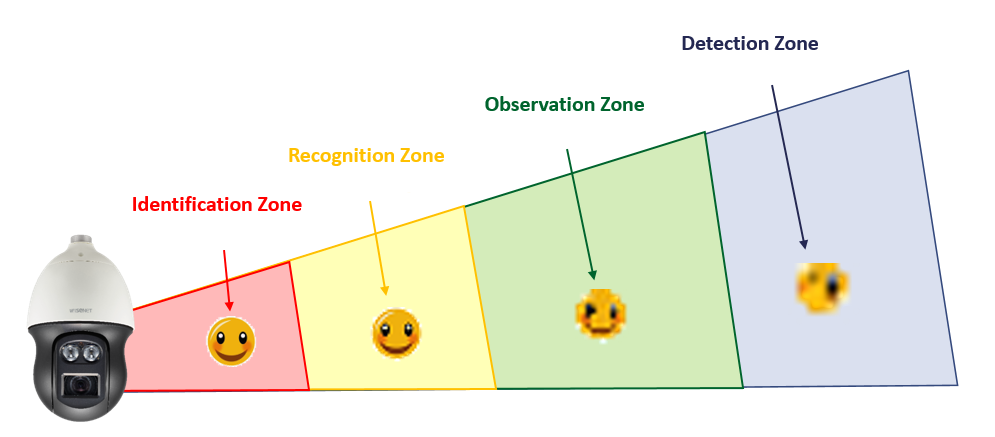The quality of the images captured by many of the latest generations of super-high definition video surveillance cameras is simply breathtaking, allowing users to see ultra-sharp detail of objects and people within the field of view.
The resolution capabilities of 4K and 8K cameras, for example, enables operators to digitally zoom in to see a non-pixelated image of just a very small part of a scene, making them an ideal solution for large open area applications where installing multiple cameras may be impractical or cost-prohibitive.
Uri Guterman, Head of Product & Marketing for Hanwha Techwin Europe, champions using the DORI (detection, observation, recognition, identification) standard as the starting point for designing a video surveillance system. In doing so, users can ensure that the specified cameras are used can meet the end user’s expectations cost-effectively.
The deployment of ultra-high-resolution cameras comes at a price, and this is not just monetary. They all capture large file size images that consume large amounts of bandwidth when transmitted over the network. They also have large data storage requirements.
Some manufacturers, such as Hanwha Techwin, have developed proprietary compression technologies that, when working in conjunction with H.265 compression, can reduce bandwidth and storage demands by up to 80%.
Let DORI help you specify the ideal camera
The phrase ‘horses for courses’ comes to mind when considering what system designers need to consider when deciding on the best camera model for each location and objective. They may, for example, need to capture high quality, evidence grade images that will identify an individual or just wish to be able to verify an intruder alarm event. In this respect, the system’s design must reflect the finding of the risk assessment and consider an end-user client’s operational requirements.
Whilst many system integrators will be familiar with DORI, installers who are relatively new to the world of video surveillance may perhaps not know that the IEC EN62676-4 international standard provides time-saving guidance as to which cameras should be specified. So for those unfamiliar with the standard, here is a jargon-busting overview of what the DORI acronym stands for.
- Detection: The quality of images captured by a camera allows a user to determine whether a person or vehicle is present.
- Observation: The captured images are able to provide characteristic details of an individual, such as their clothing.
- Recognition: The clarity of the images enables operators to see with a high level of certainty that an object or incident is the same as the one that an operator has seen before, e.g. it is a person, vehicle or fire.
- Identification: The resolution and quality of the images enable an individual to be identified beyond a reasonable doubt.
The ability of a camera to achieve these DORI defined objectives will depend on several factors such as the resolution, lighting and the amount of movement within the scene.
In terms of ‘Observation’, it is worth noting that sequential low-resolution images can provide as much detail (albeit of a different nature) for the human brain to process, than high resolution still images, i.e. the movement of a vehicle is very different to that of someone walking.
As an example, a 4-megapixel in daylight conditions should deliver the following:

The maximum distance that there can be between a camera and an object to meet one of the above requirements will vary depending on the lighting conditions, the compression format, camera locations and other factors.
The sensitivity of the camera sensors used by different camera manufacturers will also vary, and in this respect, Hanwha Techwin’s online Toolbox Plus enables system integrators to compare the specifications of its Wisenet cameras side-by-side and then compile a list of the products required for a specific project. There is also the added benefit of generating a report on the estimated bandwidth and storage requirements for the project.
It seems almost too simple, but using DORI as a guide for designing a new video surveillance solution, will ensure you do not waste money by over-specifying the cameras needed for the job at hand. Equally important, the reverse also applies in that the DORI standard will help you avoid experiencing ‘buyers’ remorse’ due to installing cameras that are not fit for purpose.
However, it is crucial to bear in mind that DORI is a guide to ensuring you don’t specify an unsuitable camera, but on its own is not going to choose the perfect camera for you. Other requirements need to be considered, such as if the camera will need to have built-in IR illumination or/or have good WDR functionality because it will be pointing towards an outside window and will have to deal with variable lighting conditions.
As always, the best advice is, therefore, to work with manufacturers you believe you can trust and ask them to confirm that you have made the correct camera choice.







